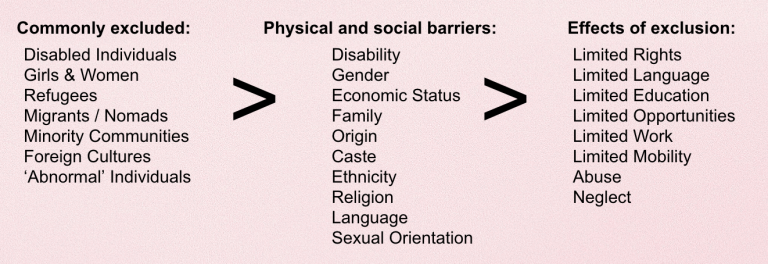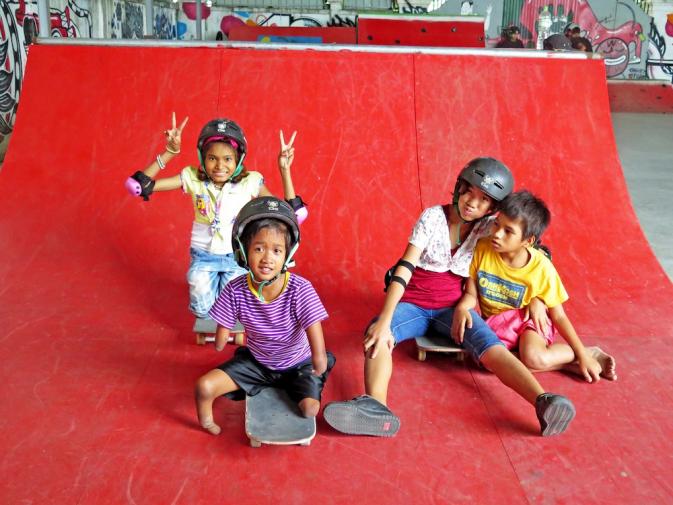Social Inclusion
What is “Social Inclusion”?
Social inclusion means finding ways to encourage all individuals and groups to take part in your programs (and in society). Inclusive programs provide opportunities and dignity to people who are facing discrimination and inequality.

Why be Inclusive?
The problem:
- Marginalized people lack opportunities to learn, play, make friends & reach their full potential
- Costs, social norms, and conflict limit access to safe, free play spaces for youth, holding back their personal development.
- Girls need a boost – gender inequality is an issue worldwide. Take special steps to help girls overcome deep-rooted social and cultural barriers to their involvement in skateboarding, sports and education.
- Unless special efforts are made to include people facing additional barriers, your project is unlikely to reach those who may benefit the most
Be a part of the solution!
- Diversity is a society’s strength. An essential step to building strong communities is to encourage participation from people who are usually excluded based on ethnicity, economic status, ability, gender and other factors.
- Building trust and friendships is a much-needed first step towards overcoming ethnic and class divisions in communities, countering gender inequality, and reducing discrimination.
- Working with the young generation creates positive role models within divided communities, who can contribute to positive social change in the long-term
Why Skateboarding?
- Skateboarding is a uniquely effective tool. Its simplicity makes it widely accessible and uncomplicated to pursue, and its creativity inspires people to push their own limits, regardless of physical or cognitive disabilities
- It is a simple concept with an accessible entry point – stand (or sit!) on the board, push.
- A skateboard can keep even the most challenging children engaged, yet skateboarding presents challenges that can engage an individual over a lifetime.
- It is a non-competitive, individual activity that allows youth of all backgrounds and abilities to come together as part of a community.
- Skateboarding builds confidence, social supports and new friendships, in short the skills to reach their personal potential and make positive contributions, big or small, to their communities.
- Skateboarding is a relatively new sport, so is less likely to be seen as a “sport just for boys” and more likely to be accepted as an activity for girls as well (skateboarding is not subject to existing cultural restrictions of more established sports like football)
- This is most effective if girls are included and female role models are present from the very start in a new community
- It also provides a pathway to connect participants to larger educational and personal development opportunities.
Video of Skateistan Educators in Afghanistan teaching a deaf skateboarding class
What does an inclusive skate program look like?
- Is a safe and supportive environment where all youth feel welcomed.
- Includes low-income communities, provide access to facilities, equipment and instruction free of charge.
- Has participant recruitment policies that favour vulnerable youth and girls
- Has a strong focus on staff training to create a supportive environment
- Involved the community at all stages – from building the skatepark, to registering participants and celebrating events.
- Encourages female participation (especially 13 and up), provides privacy for female students, and girls-only skate classes and skilled female instructors.
- Reaches out to newcomer and ethnic minority children and their families since these youth may not be afforded the same access to public services as permanent residents and citizens.
- Has disabled access to the skatepark and learning areas
Other tips for making your project inclusive:
- For culture of inclusion to be most successful, sessions should be facilitated or co-facilitated by members of the demographic you are seeking to reach (females, youth with disabilities, low-income, ethnic minorities). It’s important to provide role models to participants, and to reflect inclusion commitment within the staffing.
- Put up a sign that says discrimination won’t be tolerated and be consistent in reinforcing the policies.
- Participants with differing disabilities do not necessarily wish to always be placed together in one group. People with disabilities should be given the option of joining the open session classes if they feel comfortable to do so.
- Don’t expect people from a demographic to speak for/represent all of that demographic.
- Track progress (if capacity allows, it can be insightful to collect data that is separated by gender).
- Finds ways to adapt the skateboard sessions depending on ability-levels:
Tin, Skateistan Cambodia’s Programs Officer, describes her experience teaching blind students:
“At first, I explained to the children what a skateboard was and encouraged them to discover it by touching. Then I asked them to sit on a board and count three steps. [In pairs] I asked them to rely on their hearing to find their friend. They enjoyed the game so much! They are not yet standing on the skateboard, we are reflecting on balance activities we can do in a secure way.”

Next Steps:
1. Set goals: The most important step is to decide that you want to make your programs inclusive.
- Set goals on who you want to involve in your programs and be persistent.
- Note: It’s easier to be inclusive right from the start than to try to make it happen later, since a culture of exclusiveness and division will already be established. Those who aren’t from the same gender, economic background, ethnicity or level of ability may be too intimidated to participate.
2. Check out other relevant Goodpush toolkits:
- Community Engagement toolkit: For tips on connecting with new communities or demographics.
- Monitoring, Evaluation & Learning toolkit: For tips on figuring out what impact your project aims to achieve, and how you can measure your progress along the way
3. Do the Keep Girls In Sport e-course
- This free online course from Adidas and Up2Us is a great resource for anyone who is coaching girls and young women, or wants to find ways to get more girls involved in their skateboarding/sport programs.
4. Keep Learning!
- Check out our new (and free!) Goodpush E-Course on the Inclusion of Girls & Women in skateboarding programs. This module aims to give an overview of the various barriers affecting girls' and women's inclusion, as well as how you design your programs to reach more women and girls.